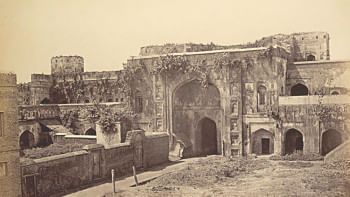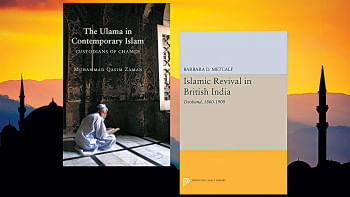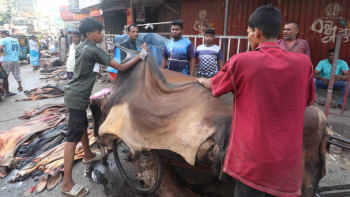Politics of destroying shrines and unmaking places

The July insurrection was spawned from the apolitical banner of the quota reform movement. In the space of 20 days, an apolitical reformist movement escalated into a quintessential political event: a popular insurrection.
By August 1, the very apolitical hyperpolitics of the July insurrection converged into one point: the resignation of Sheikh Hasina. The subtractive demand for toppling an authoritarian regime was achieved within the next five days when the positive political content of the insurrection was still indeterminate. Thanks to that indeterminacy, a diverse range of social elements could project and invest their respective desires into the vast, formal shell of the insurrection.
Freud used the term "cathexis" to indicate the investment of desires onto a psychical object. We might say, a sort of pan-cathexis was at work in the July insurrection. One of those elements in the unfolding political process was the Salafi element that seeks to eradicate the culture of tomb veneration.
There is probably no cause for universal alarm. Only a small percentage of shrines and tombs have been attacked so far. But it is probably apposite to understand and characterise the tendency before it launches onto a bigger campaign in the coming days.
My suggestion in this brief epistle is that we should read the recent mazar destruction campaign in terms of certain "political desires" of the campaign proponents, instead of being distracted by arguments about the theological merit or otherwise of those actions.
Criticism of shrine culture is not a novelty in Islam or in South Asia. Tasawwuf as a modality of Islamic piety always had a deep dialectic at its heart. It was as much a self-recapitulating heritage as it was a mode of radical self-criticism. Thus, Sufism itself generated repeated impetuses of self-purification—motivating various saints to cast aspersions on mass devotional practices. But popular Islamic culture faced attacks from without as well, such as the destruction of tombs by the Wahhabi militia in Hejaz—a paradigmatic case.
In Bengal itself, a new mode of Sufi praxis was scaled up in the colonial period that denounced certain longstanding practices around tombs—like devotional gestures and the ritual Urs—as shirk and bidah. Under the broad umbrella Tariqah i Muhammadiyah, for example, many shaikhs called for a purification of Islamic practices from the overgrowth of "rasm" or customs. However, the Tariqah sought to undertake this purification from within the rubric of tasawwuf itself. Shrines were not meant to be razed to the ground—one only had to refrain from practices that were seen to go against the grain of God's unity (tawhid).
Beyond the respectable high culture of tasawwuf, even within the rural, working-class culture of fakiri, there was a critical discourse about the devotional cults built around tombs and living ascetics. Lalon Fakir, for example, was heavily critical about various questionable dervish practices. Referring to the dargahs in Penro, ie, Pandua—the location of major dargahs like that of Jalaluddin Tabrizi and Nur Qutb Alam, Lalan criticises the false beliefs and accompanying practices of gift-giving:
"In the Penro dargah, the ghost is emancipated if one offers faita (futuh)... Instead one should die before one's death—and become a living-dead—to offer futuh to one's own soul."
The mode of self-care suggested by Lalon here is more congruous with Nur Qutb Alam's platonic spirituality than the prevalent practices at the Penro dargahs.
Thus, both high Sufism as well as working class fakiri culture developed strong critical discourses about inauthentic spectacles of sanctity around shrines and tombs that were aimed at unburdening the devotees of their money.
However, wholesale dismissal of Sufism or the calls to destroy mazars from Bengal seems to have assumed new dimensions. It builds on a khariji habitus of labelling those with theological differences as disbelievers. The recent call for the wholesale destruction of shrines thus reminds one of the actions of khariji groups that have destroyed pre-Islamic as well as Islamic tombs and shrines in Syria and Iraq in recent years.
There is a broader question of identity and place-making to understanding Islam in Bengal. Over the centuries since Islam's advent in Bengal, the hospices and shrines of fakirs and "pirified" notables, their memories and heirlooms turned the so-called "frontier" region (a place that is gharib) into a land replete with the aura of established holiness. From Baba Adam to Shah Jalal, the tombs of countless shaikhs encouraged the chishti saint Nur Qutb Alam to consider Bengal a sacred realm. The shrines and saints have been integral to popular life of Hindus, Muslims and indigenous communities of Bengal. When Apu, the fictional hero in Bibhutibhusan Bandapadhyay's Pather Panchali, was born in a brahmin family, the midwife made apotropaic offerings to a local shrine of a pir.
This legacy of place-making continued into 20th century Bengal politics. While Maulana Bhasani himself was a pir, Sheikh Mujibur Rahman ended his February 1966 booklet on the six points identifying himself as a "khadem" of the people, and asking his "brothers and sisters" to pray to "Allah's dargah" so that he could remain a people's khadem till his last breath. Spiritual terminology borrowed from tasawwuf was not strange to Bengal politics—religious or secular. In March 1971, the non-cooperation programme would involve visiting and offering respect to shrines of martyrs and that of AK Fazlul Haq.
Criticism of shrine culture is not a novelty in Islam or in South Asia. Tasawwuf as a modality of Islamic piety always had a deep dialectic at its heart. It was as much a self-recapitulating heritage as it was a mode of radical self-criticism. Thus, Sufism itself generated repeated impetuses of self-purification—motivating various saints to cast aspersions on mass devotional practices. But popular Islamic culture faced attacks from without as well, such as the destruction of tombs by the Wahhabi militia in Hejaz—a paradigmatic case.
What then does the desecration of tombs mean for this legacy of place-making in Bengal?
Scholars of genocide have noted how across world history, destruction of graveyards and tombs was a common means used to eliminate the cultural identity of entire groups. One would wonder if the "political desire" that inspires the anti-mazar ideology is not about unmaking the memory-laden location of Islam in the life of emplaced communities in Bengal.
Such an ideology thus prefers a deterritorialised religious culture piggybacking on global content flows in digital platforms. The new Salafi intelligentsia cultivates a certain kind of techno-religiosity supported by the new media of techno-feudalist platforms and "heno-lingual" globalisation.
But when we speak of criticism of mazar and pir culture, why not consider the other strand of anti-mazar discourse? What about Laalsalu—the renowned novel by Syed Waliullah, people may ask.
Waliullah wrote in a modernist vein—but that strand of modernism was not necessarily about political disenfranchisement of Muslims. Quite the contrary. The key concern for Waliullah and his ilk was probably the very conditions of production of political subjects in the context of post/colonial world. One would find the same kind of critical discourse about off-political Sufi culture in the work of someone like Muhammad Iqbal—respected as an "Allama"—who developed an entire philosophical discourse around the concept of the authoritarian ego (khudi) as the ideal Muslim subject. When it came to the heavy baggage of pir-centred Islamic culture, the secularist Kazi Abdul Wadud and the political theologian Abul Hashim could probably agree that one needed a more pristine recapitulation of Islam. How that modernist-Salafist consensus was shattered can be discussed on another occasion.
Techno-religiosity produces its own immanent contradictions. Salafi influencers denounce the devotional relation between the master and the disciple as practiced in Tasawwuf. Yet as they gain a wider, hybrid following across online platforms like YouTube or Facebook as well as offline events, their listeners begin to see these Salafi influencers as quasi-omniscient shaikhs. In an unavoidable division of labour, ordinary pious Muslims rely on the digital shaikhs to learn what is right in the minutest aspects of their daily lives. While in the heyday of Chishti Sufis the dargah could act as an axis of resource redistribution through futuh and charity, today Salafi digital influencers establish charities through which they mobilise comparable patterns of pietistic gift-giving for resource redistribution. They create a whole array of business enterprises branded Islamic while acquiescing to the epistemic and political parameters of late capitalist modernity.
The neo-Salafists' fascination with ultra-masculinity hinging on a vulgar materialist ontology of hormones, or the aesthetic techniques used to boost views of religious content may be as addictive and manipulative as the proverbial malpractices in the shrines that trigger so much of the Salafist animus.
A placeless global field navigated by a self that uses coercion and destruction to establish its own mode of self-growth based on a codified content—this is as much a neoliberal ideology of fossil fuel-based capitalist civilisation, as it is a new techno-Salafists' way of dealing with difference.
Tahmidal Zami is a journalist and writer. He is the coordinator of Bengal History Collective. He can be reached at [email protected]
Views expressed in this article are the author's own.
Follow The Daily Star Opinion on Facebook for the latest opinions, commentaries and analyses by experts and professionals. To contribute your article or letter to The Daily Star Opinion, see our guidelines for submission.

 For all latest news, follow The Daily Star's Google News channel.
For all latest news, follow The Daily Star's Google News channel. 







Comments